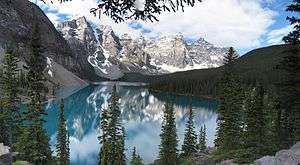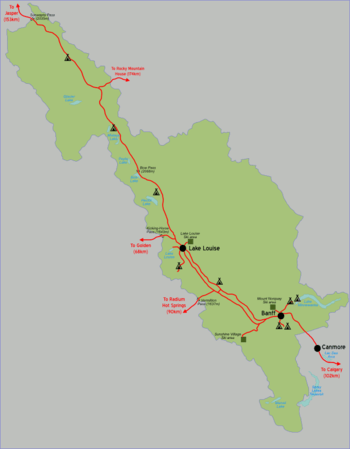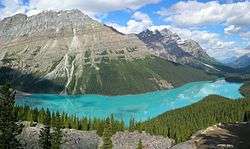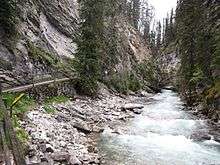Banff National Park
Banff National Park is in the Alberta Rockies region of Alberta, Canada. Together with six other national parks it makes up the UNESCO World Heritage site "Canadian Rocky Mountain Parks".
Towns & villages
Understand
Established in 1885, Banff National Park is Canada's first national park, and its creation gave birth to Canada's national park system. At 6,641 km², it is also one of the largest national parks in Canada. The park sees visits well into the millions annually.
- 🌍 Banff Information Centre, 224 Banff Av, ☎ +1 403-762-1550, fax: +1 403-762-3380, e-mail: banff.vrc@pc.gc.ca. Banff. Hours: Winter (Jan 1 to May 17) 9AM-5PM; Spring (May 18 to June 20) 9AM-7PM; Summer (June 21 to Sept 3) 8AM-8PM; Fall (Sept 4 to 19) 9AM-7PM; Winter (Sept 20 to May 16) 9AM-5PM. Closed December 25.
- 🌍 Lake Louise Visitor Centre, 201 Village Road (near Sampson Mall Lake Louise), ☎ +1 403-522-3833, fax: +1 403-522-1212, e-mail: mailto:ll.info@pc.gc.ca. Winter (January 1 to April 29) 9AM-4PM; Spring (April 30 to June 21) 9AM-5PM; Summer (June 22 to Sept 8) 9AM-8PM; Fall (Sept 9 to Sept 15) 9AM-7PM; Fall (Sept 16 to Sept 22) 9AM-5PM; Winter (Sept 23 to April 30) 9AM-4PM. Closed Dec. 25.
The park starts in the north at 🌍 Sunwapta pass just south of the Columbia Icefield and Jasper National Park with the 🌍 southern park entrance just north of Canmore. The town of Banff and the village and resort of Lake Louise are within the park. The other park entrances are from the east near the 🌍 Saskatchewan River Crossing and from the west at 🌍 Kicking Horse Pass and 🌍 Vermilion Pass.
History
This area was inhabited by the Nakoda (Stoney) Indians thousands of years before the white man arrived. The area was explored by the workers building the transcontinental railway in 1882. At first the park was centered around the Cave and Basin Hot Springs, and was officially born in 1885. The first Banff Springs Hotel was built three years later, the current incarnation was built in 1928. The first highway through the park was completed in 1923. The park boundaries as they are today were drawn up in 1930, as part of the National Parks Act passed by Canadian Parliament.
Landscape

Other than the townsites of Banff and Lake Louise, the three ski areas (Norquay, Sunshine Village, and Lake Louise), and the highways that bisect the park, it is about 93 percent untouched wilderness. The most dominant feature is of course the mountains, of which vistas are present from anywhere in any direction.
Flora and fauna
The most common wildlife seen in the park are bighorn sheep, deer, and North American elk. Moose are more elusive (their population is in decline) and mountain goats are virtually undetectable on the mountainsides without a good pair of binoculars. (Visitors often mistake female bighorn sheep for mountain goats, because female bighorns have short horns somewhat like those of mountain goats.) Although caribou are present in the park, they are rarely seen by visitors. It is important to keep in mind the park is also home to black bears, grizzly bears, wolves, coyotes, and cougars (mountain lions).
On the warmer and fuzzier side, the park is home to many tree squirrels, ground squirrels, chipmunks, and marmots. The occasional porcupine and beaver may also be found. Bird lovers will want to watch for Ruffed Grouse, Bald Eagles, and the ubiquitous Canada Goose.
Climate
In summer the climate is generally mild. July is the warmest month, with an average temperature of 22 °C. There is rarely snow at highway level in the summer, but the mountain tops will be snow covered year round. In winter the average temperature drops drastically. January is the coldest month with an average of -15 °C. Snow will be found at any elevation in the winter, and harsh winter conditions can be expected anywhere at any time. No matter the season, it is important to consider that the temperature will drop 1 °C for every 200 m of elevation gained.
Get in

By car
Highway 1 (Trans-Canada Highway) bisects the park east/west. Banff is about an hour and a half from Calgary Alberta and the same from Golden British Columbia. Other ways to enter the park by automobile include the Icefields Parkway from Jasper, Highway 11 from Rocky Mountain House and Red Deer Alberta, and Highway 93 from Radium Hot Springs and Cranbrook British Columbia.
By bus
|
Greyhound Canada Greyhound Canada terminated all services in Western Canada and Northern Ontario effective October 31, 2018. |
- Brewster provides regular scheduled coaches that serve Banff and Lake Louise, departing from Calgary and points in British Columbia.
- Rider Express, toll-free: +1-833-583-3636. Bus service along the Trans-Canada Highway from Winnipeg to Vancouver, twice daily. Service from Revelstoke, Salmon Arm, Kamloops, Hope, Abbotsford, and Vancouver (British Columbia); Calgary, Strathmore, Canmore, Lake Louise, and Banff (Alberta); Medicine Hat, Swift Current, Moose Jaw, Regina, Whitewood, and Moosomin (Saskatchewan); and Brandon, and Winnipeg (Manitoba).
- On-It Regional Transit. On-It offers seasonal bus service on weekends and holiday Mondays between Calgary and Banff. There are also Friday evening runs. ON-It passengers may transfer free to Roam transit buses in Banff and Canmore, but must pay a separate fee to enter Banff Park.
- Another option is to book one of the many guided bus tours that visit the park. Most of these will depart from Calgary or Vancouver.
There are three airport shuttle providers from the Calgary Airport to Banff and Lake Louise:
- Banff Airporter offers many shuttles daily or private charter shuttles if needed.
- Brewster Banff Airport Express offers shuttle service from the Calgary airport, downtown Calgary, Edmonton airport, and the West Edmonton Mall. (Edmonton service is via Jasper and is offered in partnership with Sun Dog Tours. Schedules vary with the seasons.
By train
Explore the Canadian Rockies by rail. Day rail tours depart from Banff connecting to Vancouver.
- Rocky Mountaineer Vacations, provides independent year round vacation packages to the most unique and scenic regions of Canada, including travel on the world acclaimed Rocky Mountaineer rail journey.
Between Mid-April and Mid-October, the two-day, all daylight Rocky Mountaineer travels between Vancouver or Whistler, British Columbia and the Rocky Mountain destinations of Jasper, Banff or Calgary Alberta. Guests relax in Redleaf or Goldleaf Service, enjoying onboard commentary and bi-regional cuisine as the awe-inspiring scenery passes by at a leisurely pace. For selected departure date in December, the festive Rocky Mountaineer travels through a winter wonderland where the mountain valleys are covered in a blanket of snow.
By air
The closest international airport is in Calgary. Vancouver International Airport is approximately 12 hours' drive to the west. Springbank Airport (west of Calgary, towards Banff) is nearly 80 km from Banff. Springbank operates short charter flights with small aircraft. There is a heliport in Cochrane, 5 minutes drive east of the park boundary and a 15-minute drive from the town of Banff.
Fees and permits
All visitors stopping in the park (even just for gas) require a park permit. If you are driving through non-stop, the pass is not required. Day passes and annual passes are available.
All Canadian National Parks require visitors to pay an entry fee. Your citizenship or place of residence does not change what you pay; Canadian residents and international visitors pay the same fees. The national parks in Alberta and BC are fairly close to each other and it is possible to visit several of them in a single day. If you pay an entry fee in one mountain park (e.g. Banff National Park), and visit another on the same day (e.g. Yoho National Park), you will not have to pay a second time. Your paid entry fee is valid until 4PM the following day.
The fees that visitors pay do not go to general government revenues; they are used to enhance and maintain the parks and visitor services.
The daily entry fees for 2018 are:
- $9.80 for an adult (aged 18-64)
- $8.30 for a senior (aged 65+)
- free for children and youth (17 and under)
- $19.60 for a family/group (up to 7 people arriving in one vehicle)
Parks Canada Passes
The Discovery Pass provides unlimited admission for a full year at over 80 Parks Canada places that typically charge a daily entrance fee It provides faster entry and is valid for 12 months from date of purchase. Prices for 2018 (taxes included):
- Family/group (up to 7 people in a vehicle): $136.40
- Children and youth (0-17): free
- Adult (18-64): $67.70
- Senior (65+): $57.90
The Cultural Access Pass: people who have received their Canadian citizenship in the past year can qualify for free entry to some sites.
A Discovery Pass includes admission to national historic sites operated by Parks Canada, such as the Banff Park Museum, Cave and Basin National Historic Site, Bar U Ranch, Rocky Mountain House National Historic Site, Fort Langley National Historic Site, and more. Parks Canada does not operate all of Canada's national historic sites.
All passes can be purchased at the visitor centers at Banff and Lake Louise or at the tourism website. The Parks Canada website only allows purchase of the Annual Discovery Pass. Visitors staying in for at least 7 days are better off purchasing the annual Discovery Park pass. If you purchase online at the tourism website, it will recommend the cheapest method after you enter your visiting dates.
Additional variable fees are required for camping and backcountry exploration. See the official Parks Canada website for a complete current schedule.
Get around
- By far the easiest way to get around is by vehicle. Vehicle rentals are available in Calgary, Banff and Lake Louise. The only places to purchase fuel in the park are in Banff and Lake Louise.
- It is also possible to cover the park on bicycle, but the mountainous terrain will make this quite a workout. Bicycle rentals (town, road and mountain bikes) are also available with in Banff and Lake Louise, visit the Parks Canada information centre for road and trail routes.
- GyPSy Guide provides the self-drive visitors with a guided tour. GyPSy Guide automatically plays audio commentary, depending on your location, and through the stereo of any vehicle as you tour through the National Parks and beyond. No buttons to push, it knows where you are!
See
There are several nature trails within half an hour of Banff township. These feature wildlife, waterfalls, lakes, rivers, and mountains. Banff is located at a high latitude and thus the scenery is four-seasonal; Banff looks completely different in the winter than it does in the summer.


- 🌍 Lake Louise. Glacial lake with impressive mountain backdrop.
- 🌍 Peyto Lake. A scenic location on the Icefields Parkway about 40 km north of the town of Lake Louise. Access to the viewing area for this magnificent area is immediately off the parkway and is well signposted. Upon climbing the short distance to the viewing point you are greeted by what many consider to be one of the best views in Canada. The lake is located in a convergence of valleys surrounded by majestic mountains and rich forests. The lake system is fed from the Peyto Glacier to the left of the view point and this gives the lake a magnificent blue colour in the summer months due to the mineral content.
- 🌍 Moraine Lake. Scenic mountain location with the lake an incredible blue colour due to the glacial rock flour. A short paved walk up from the car park provides some spectacular views of the lake. By 8:30AM the coach groups start to arrive.
- 🌍 Johnston Canyon (Parking next to Johnston Canyon Resort). 11-km hike up the narrow Johnston Creek passed a spectacular waterfalls (2.7 km from car park) to the Ink Pots, six blue-green spring-fed pools.
- 🌍 Sunshine Meadows. For hikes amongst beautiful alpine meadows. Circular hike of about 6 km from the Sunshine Village.
- 🌍 Lake Minnewanka (Scenic drive to the lake from Banff).
Do
- 🌍 Banff Gondola, 1 Mountain Ave (is located just at the edge of the town of Banff). Operates year-round (except for a week of scheduled maintenance in January).
- 🌍 Lake Louise Sightseeing Gondola, 1 Whitehorn Road (at the Lake Louise Ski Area). Only operates in the summer season..
- 🌍 Ski Sunshine Village, 1 Sunshine access Rd, ☎ +1 403-762-6500. 8 km west of Banff on Highway 1. 3358 acres of lift-accessed terrain on three mountains. With a peak elevation of 2730 m, you can see well into British Columbia from the top. Adult $83/day, student $49/day.
- 🌍 Ski Lake Louise, 1 Whitehorn Road. 60 km west of Banff on Highway 1. 4200 acres of lift-accessed terrain on four mountains makes this resort the largest single ski area in Canada. Adult $64/day, student $51/day.
- 🌍 Ski Mount Norquay, 2 Mt Norquay Rd. 6 km north of Banff on the Mount Norquay access road. 190 acres of lift-accessed terrain. Norquay is famous for its super-steeps serviced by the original double chair. Adult $52/day, student $40/day.
- 🌍 Golf - The Fairmont Banff Springs, 405 Spray Avenue. Teeing-off amongst the backdrop of dramatic mountain ranges, with local wildlife as your gallery, is an unequalled golfing experience. Stanley Thompson, Canada's master golf course architect, used his expert talent when he designed the original 18 holes in 1928. The course winds along the Bow River under the snow-capped peaks of Sulphur Mountain and Mount Rundle. In 1989, the course was complemented with the construction of an adjoining 9 holes, designed by Cornish and Robinson, resulting in 27 holes of championship layout.
- Kayaking. A lot of the lakes in Banff National Park allow kayaking. Some nice places to do it are Lake Louise or Lake Moraine.
- 🌍 Johnston Canyon Icewalk. A walk along the suspended catwalks of Johnston Canyon (30 minutes from Banff) to see the frozen Lower and Upper Falls. Hiking poles, ice cleats, and a snack is included. Make sure to dress warmly.
Visit the official site for Banff Lake Louise Tourism to find any activity you may be looking for whether it's horseback riding, fishing, sightseeing, ATV adventures, white water rafting, kayaking, and canoeing. Banff National Park also offers a large variety of activities besides skiing and snowboarding in the winter. Try your hand at dogsledding, icefishing, ice skating, snowshoeing, cross-country skiing, ice climbing.
Buy
In nearby towns, such as Banff, Canmore and Jasper, you may enjoy strolling alongside locals and world-travellers as you discover a cosmopolitan collection of galleries, boutiques and cafés. Shops range from internationally recognized clothiers or independently-owned establishments to Canada's oldest department store. The village of Lake Louise also has a few places to purchase supplies.
Eat
With inventive panache, chefs relentlessly reach new culinary heights. Recipes change according to the seasons and make use of the freshest local ingredients. During the fall and winter, this means game, squash and legumes, while spring features asparagus and mushrooms and summer highlights edible flowers and fresh fruits. The majority of restaurants are found in Banff town, with a few at other resorts in the park.
Drink
Banff town has a large variety of places to sit and enjoy a drink whether it is après ski or a patio.
Sleep
Whether camping or looking for a high class hotel, Banff National Park has something to offer. Camping spots are found throughout the park. Camping outside of designated spots is illegal without a special backcountry permit.
There are many hotels and lodges and bed-and-breakfasts throughout Banff. Vacation rental apartments can also be found easily. Some resorts provide log-cabin rentals. RV parking is available very close to Banff township.
Lodging
- 🌍 Simpson's Num-Ti-Jah Lodge, ☎ +1 403-522-2167. Rooms, dining, coffee shop and small gift shop.
- 🌍 HI-Castle Mountain Wilderness Hostel, Hwy 1A and Hwy 93 South, ☎ +1 778 328-2220, +1 403 762-2367, toll-free: +1-866-762-4122, fax: +1 778 328-2215. Check-in: 5PM, check-out: 10AM. A small hostel about halfway down the road towards Banff, and offers a very laid back atmosphere. The facilities are excellent, with a sizeable kitchen, friendly atmosphere and beautiful surroundings. Reservations are required during the winter months, as closure dates may apply, and recommended during the summer months to ensure a bed. Dorm beds from $23, with a $4 surcharge for non-members, ski packages available. Pets not allowed.
- 🌍 HI-Mosquito Creek Hostel, Hwy 93 North directions, ☎ +1 778 328-2220, toll-free: +1-866-762-4122, fax: +1 778 328-2215. Check-in: 5PM, check-out: 10AM. It is a simple, rustic but clean hostel, in the middle of the Rockies at 1816m along the glacier-fed creek, offering a true back-to-nature "off-the-grid" Canadian experience. World-class outdoor pursuits are literally at your doorstep here, with an on-site sauna to soothe weary muscles at the end of the day! Pets not allowed. Dorms $20-23 members, $24-27 non-members. Private rooms $58-60 members, $66-68 non-members.
- 🌍 The Crossing Resort, ☎ +1 403-761-7000.
Camping
- Parks Canada Campground Reservation Service, ☎ +1-514-335-4813, +1-866-787-6221 (TTY), toll-free: +1-877-737-3783. Banff National Park uses Parks Canada Campground Reservation Service for campsites within the park
Backcountry
- Parks Canada, ☎ +1 403-762-1550, e-mail: banff.vrc@pc.gc.ca. For registration if you are planning on camping in the backcountry.
Stay safe
Although cougar and bear attacks may get sensationalized in the media, statistically the greatest threat for injury or death in the park is driving through it. If you are unfamiliar with driving in winter conditions it is highly recommended you either find other transportation, or visit in the summer. If venturing in the backcountry you must also be aware of avalanche danger. This also applies to skiing out of bounds, in three words: Don't do it.
Elk, moose and deer are unpredictable and potentially dangerous, especially females with young (May and June) and males during the mating season (September through November). Remember, stay at least 30 metres (3 bus-lengths) away from any elk, moose or deer.
Elk in some areas of the park are accustomed to the presence of people and automobiles. Do not think you can photograph a bull elk (i.e. one with antlers) from close-up by driving slowly past it while you shoot. Especially during mating season, bull elk will attack an automobile without warning, and can cause serious damage.
Wolves and coyotes are often seen on trails and along roads. Cougars are elusive and rarely seen, but they do live here. The chance of being approached by these carnivores is unlikely, but if you are approached, send a clear message that you are not prey.
- Pick up small children immediately.
- Try to appear bigger, by holding your arms or an object over your head.
- Face the animal and retreat slowly. Do not run or play dead.
- Maintain steady eye contact with the animal.
- If the animal continues to approach, deter an attack by yelling, waving a stick or throwing rocks.
- If you are attacked, fight back. Hit the animal with a heavy stick or rock.
Rules to follow for your safety and theirs:
- Give all the wild animals you see the respect they deserve and the space they need.
- Use your binoculars to see animals up close, and use telephoto for your photos.
- Remain at least 100 metres (10 bus lengths) away from bears, cougars, and wolves.
- Keep back at least 30 metres (3 bus lengths) from elk, moose, and deer. Bighorn sheep are especially tolerant of our presence, but you should still give them at least 10 metres of space.
- When viewing roadside wildlife remain in your vehicle and move on after a few seconds.
Learn more and educate yourself from a reliable source.
Ask park staff about wildlife safety, and how you can keep wildlife wild– and alive, or read Parks Canada wildlife publications available at information centers or on the Parks Canada website.
Emergency contacts
- Ambulance, Police and Fire: 9-1-1.
- Park Wardens, ☎ +1 403-762-4506. 24 hours.
- 🌍 Banff Mineral Springs Hospital, 305 Lynx St, ☎ +1 403-762-2222.
- 🌍 Lake Louise Medical Clinic, 200 Hector Rd, ☎ +1 403-522-2184.
Go next
Although Banff is considered one of the best places to "get out" of the nearby cities, these nearby destinations are great:
- Jasper National Park: Just as spectacular scenery with a little fewer tourists
- Yoho National Park: Once away from the few car parks, real away from people destination.
The nearest major cities are:
- Edmonton Capital of Alberta, from the National part to Edmonton Mall for a real cultural contrast.
- Calgary Colder and smaller version of Dallas. Stampede week, one of the great world parties, and rodeo.
| Routes through Banff National Park |
| Kamloops ← Field (in Yoho N.P.) ← | W |
→ Canmore → Calgary |
| ENDS at |
N |
→ Red Deer → Rocky Mountain House |
| END ← Jasper (in Jasper N.P.) ← | N |
→ Kootenay N.P. → Cranbrook |